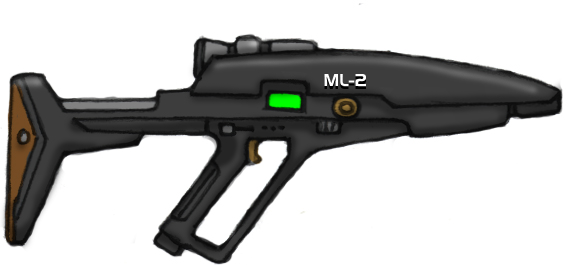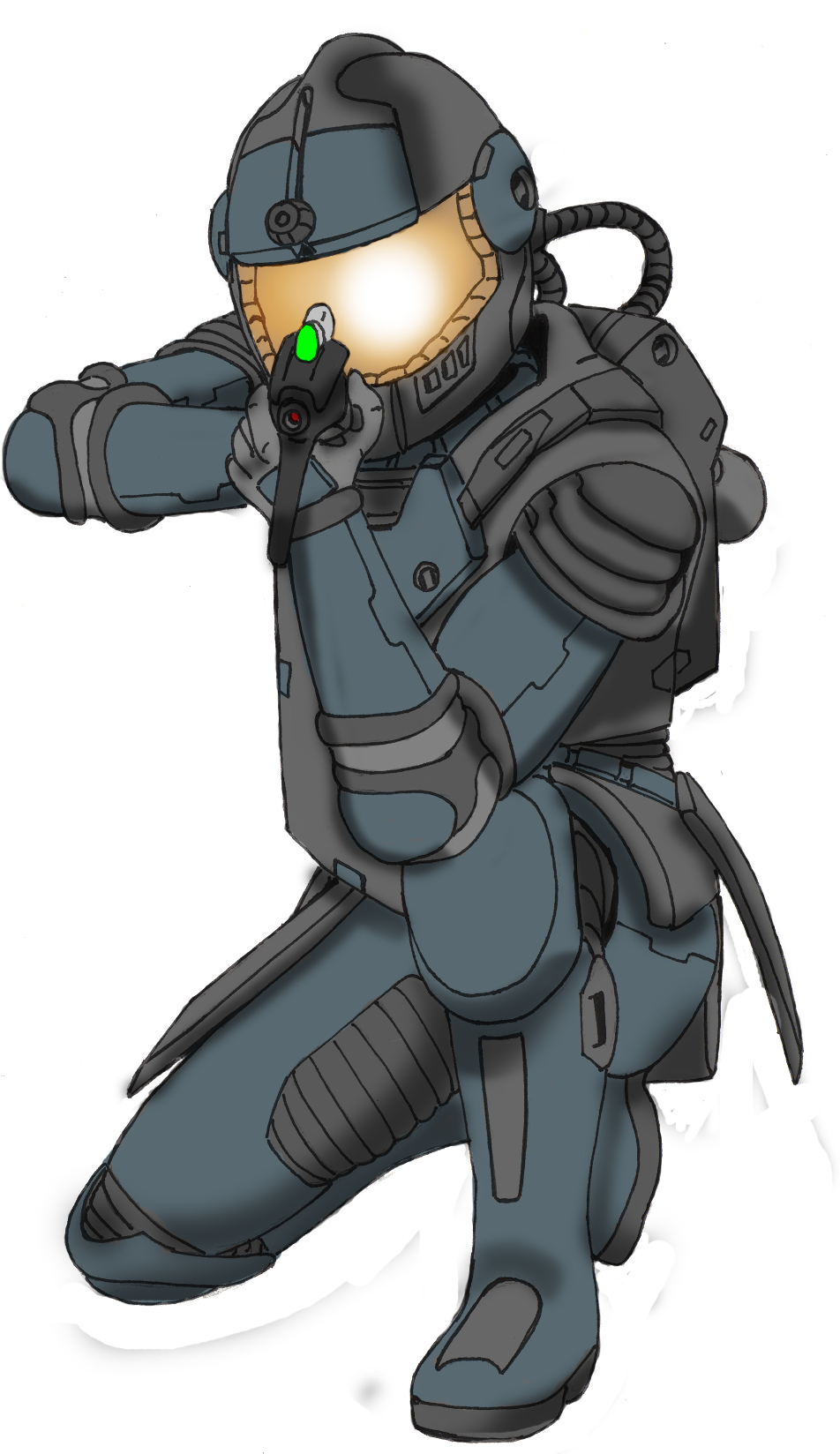 |
EFSM SMALL ARMS & EQUIPMENT(Version 1- Last Modified: Sunday, January 22nd, 2012)RPG Stats by Kodai Okuda (primeadministrator@nexusarcana.com) |
|
 |
EFSM SMALL ARMS & EQUIPMENT(Version 1- Last Modified: Sunday, January 22nd, 2012)RPG Stats by Kodai Okuda (primeadministrator@nexusarcana.com) |
|
Just prior to the start of the 1st Interplanetary War, and for the first two years of the war, the EFSM used
surplus weaponry and equipment from the USSN and older EFR weapons stores. Thus, it was not unusual for spacemarines to arm themselves with LAR-51 battle rifles or PG-62 plasma rifles, and wear HCA-01 or USSN EVA-01 hard-armor.
After the Battle of Ceres in 2071 AD however, the Earth Federal Space Marines were issued the same small arms and equipment as all of the other Earth Federal Forces (EFSN and planetary defense forces). Therefore, the EFSM used the ML-1, ML-2, and ML-3 laser weapons and the PG-74 plasma gun as their
principle small arms. The equipment of the EFSM consisted of the LCA-01 and HCA-01 combat armors.

Nippon Military Industries built the ML-1 laser pistol as a replacement for the numerous small-caliber firearms still in use by the USSN and EFR forces. Introduced in 2070, this weapon was one of two types of energy weapons built by Nippon Military Industries for both the professional armed forces and the citizen militia forces of the Earth Federal Republic. This weapon was a .48 caliber, 4.9-kilowatt laser pistol with both semi-auto and tri-burst capability. Its detachable energy-clip had a 100-blast capacity.
DATE:2070
NAME:ML-1 Laser Pistol
DAMAGE/PF:6D6+3/3.9
SUPER/PR:10/1
COST:9.6 sp
WEIGHT:2.7 lbs.
RANGE:82 yards
ROF/PAY:3B/100
TYPE:.48 caliber, 4.9 kilowatt, tri-burst laser pistol
FEED: 100 shot energy-clip (nuclear battery), WT: .25 lbs., SUPER/PR: 1/.01, COST: 1.2 sp.

The ML-2 was the second weapon built by Nippon Military Industries for the EFR professional military forces and the citizen militia groups. This laser carbine was very popular with mecha and spacefighter pilots as well as SpaceNavy crewmembers and security details. This .48 caliber, 4.9-kilowatt laser weapon was capable of single or tri-burst modes and used a different 100-shot detachable battery clip than did the ML-1. This was due mostly to the fact that the ML-2 fired a slightly more powerful and longer range beam than did the ML-1 and thus needed extra power in its energy-magazine.
DATE:2070
Norking Weapons was the contractor who won the Earth Federal Forces infantry small arms contract and thus built the first mass-produced laser rifle weapons. The ML-3 was a .48 caliber, 7-kilowatt laser rifle capable of firing in single shots or triple bursts. This laser weapon had a much longer range than either the ML-1 or ML-2 and shot a more powerful laser bolt. This weapon used a 100-blast detachable battery clip, which was not compatible with either the ML-1 or the ML-2 laser weapons.

The PG-62 was an extremely successful design and very effective against UN armored vehicles. However, the PG-62 suffered from one shortcoming, that being its small magazine capacity. Therefore, as the war against the UNSC progressed, calls for a new plasma gun with more of a “punch” and more rounds began. Due to the political climate of the EFF during the second year of the 1st Interplanetary War, these demands for a new plasma weapon went unanswered. However, after the UN invasion of the Earth sphere in early 2073, the need for a new plasma rifle became glaringly apparent. The weapon was slow to develop and produce while the UNSC occupied much of the EFR surface-based mining and industrial complexes. However, the weapon designs were smuggled off of Earth to the EFSN base at Juno in late 2073 where the rifle was mass produced starting in early 2074. By February of that year, the PG-74 was ready for use in “Operation Clean Sweep.” The PG-74 was instrumental in the expulsion of the UN forces on Earth and Luna. The PG-74 remained the primary plasma rifle throughout the 2070s and early 2080s, completely replacing the PG-62 in the armories of the EFF by 2080 AD.

The space suit and combat armors of the EFR prior to 2068 were primitive when compared to the alien specimens the EFR science teams found in the lockers of the alien spaceship that crashed in the Ross Sea off the coast of Antarctica. The old EVA suit and combat armors were bulky and relied heavily on 20th-century design concepts for their basic construction. Therefore, like with the new weapon systems, the Federal Senate of the EFR called for the creation of new, more versatile EVA suits. Both suits had to be able to withstand combat conditions. The light version, which became known as the LCA-01, was intended for use by SpaceNavy personnel on ship as well as spacefighter, tank, vehicle, and battlerobot pilots.

The heavier version of the two newly developed Extra-Vehicular Activity suits was the HCA-02. This armor was designed specifically for use by infantry, security personnel, militia forces, and Regional Guard units.